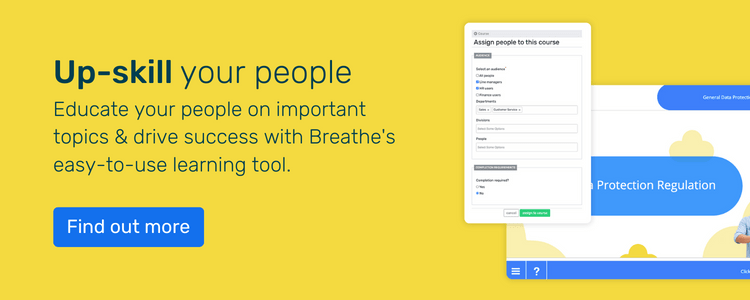A whopping 75% of senior HR leaders are looking to cut training costs, believing economic uncertainty will impact their L&D strategy.
This People Management research revealed that 49% of organisations will be spending less on their L&D programmes as a result of the economic downturn.
But what’s the long-term impact of this – and what does this mean for small businesses, in particular?
In this blog, we spoke to experts Sharon Smits, HR Consultant, and Claire Madle, L&D Specialist, both of SYLO Beyond HR & HR Partners of Breathe. We look at how SMEs can utilise the power of knowledge sharing & mentorship schemes whilst keeping L&D a priority.
We’ve explored avenues to expand L&D initiatives that won’t break the bank (or in some cases, don’t require any spending at all - talk about a win-win).
Skip to:
How learning and development (L&D) supports retention
We all know L&D is vitally important, for businesses & employees alike.
“Retaining current employees is so much better than trying to replace them. A key factor in keeping people is investing time & energy into training, collaboration & sharing knowledge – along with ensuring everyone’s aligned with the company vision and values,” notes Sharon Smits, HR Consultant at SYLO Beyond HR.
“It’s important to allow employees to grow and support them on their personal development journey – it’s worth its weight in gold to invest in your people.”
And you don’t just have to take our word for it – 70% of employees in a survey reported being likely to leave their organisation in favour of another because of better investment in employee development & training elsewhere. In a separate survey, a huge 80% of employees said that better access to L&D opportunities would help them to feel more engaged with their roles.
With data like this, can small businesses really afford not to invest in L&D?
What is collaborative learning (peer-to-peer knowledge sharing)?
Collaborative learning harnesses the internal expertise within a business – it essentially refers to when employees collaborate together to learn, or to share knowledge.
And this happens in businesses every day – probably more often than most people realise. “At SYLO Beyond HR, we regularly share knowledge between our team,” notes Sharon Smits, HR Consultant.
“As we look after many clients with different HR needs, we’ll often support each other with our different areas of expertise. We all know who in our team is the expert in certain areas, so we can use that knowledge to save time & ensure the very best advice for our clients.”
Top 3 benefits of collaborative learning for SMEs
1. When new skills are needed in a small business, SMEs may not have the budget to immediately hire for more specialist or skilled roles in the way that larger organisations can. In a small business, more senior employees could coach team members in specific areas.
For example, research reveals that the main areas that employees had a shortage of expertise were management (36% of those surveyed had gaps in this area) flexible working skills (35%) and data & digital skills (34%). If SMEs can locate the skills gaps within their organisation, they can use existing knowledge to help bridge the gaps that employees need.
2. Reduce training costs by sharing internal knowledge rather than on (often costly) outsourced training courses. Compared to spending high amounts on one day, SMEs can benefit from longer-term benefits from implementing mentoring schemes, for example, which utilise the existing knowledge within a business.
3. Increased employee engagement & morale – up-skilling and providing training internally boosts your employees’ confidence, as well as knowledge. This can also positively impact productivity rates & motivation levels.
Sharon advises thinking outside the box with this, too. “Why not mix up team structures for a bit? Encourage employees to work with or alongside colleagues they may not usually. The effects can be invigorating, and this type of initiative doesn’t cost anything.”

What can prevent employees from learning from each other?
There are many different factors that can prevent employees from collaborative learning. We’ve listed a few here, so you can be mindful of these hurdles in your SME.
-
A lack of understanding about how employees learn new things can also prevent collaboration. “Everyone has a different learning style, and there’s much more awareness around this now,” Sharon notes.
“L&D has also changed so much since even before the pandemic, which accelerated new trends – I’ve even heard of LEGO being used in new learning initiatives. It’s good to try new ways of keeping learning fresh & different, whilst also considering how individuals learn best. There’s much more awareness around neurodiversity today, too, which is crucial to an inclusive workplace environment.”
-
“Siloed teams, a lack of trust, processes not being in place and/or not designed to facilitate learning opportunities, personal agendas getting in the way and KPIs focussed on financial return – all of these limit the time and opportunity for shared learning within a business,” Claire Meadle, L&D Specialist at SYLO Beyond HR advises.
-
It’s vital to consider how people learn best and the background to their learning style, as this can be a barrier to sharing knowledge. “The way in which people learn & their generational values is a key thing to consider,” Sharon advises. “The workforce now spans several generations and there’s so much to be gained from sharing that knowledge upwards & downwards – but we need to have an understanding of that, first of all.”
-
Some managers can be reluctant to establish formal peer-to-peer learning programmes due to a perception that external providers are better trainers than those inside it, according to research by the Harvard Business Review.
-
The wrong environment can prevent successful collaborative learning. In the post-pandemic hybrid world, work has adapted – but Sharon notes that in her experience, hybrid doesn’t work best for training, in most cases. “Learning and training tends to be better face-to-face. You see better engagement and results, and it’s much easier for people to build rapport & bounce off each other.”
-
Finally, for successful peer-to-peer learning to flourish, you should have a culture where people feel psychologically safe to give and receive constructive feedback.
How mentoring can support your knowledge-sharing strategy
Developing a mentoring programme is an effective way to implement collaborative learning in your SME. This can be a powerful development tool, as long as your company culture also supports it.
-
Mentoring can help employees develop in so many ways – with technical or managerial skills, but also in terms of confidence & inspiring employees to be better.
-
Motivates employees, whilst up-skilling them
-
Mentoring’s role in company growth as a whole – makes it an attractive place to work, invested in development
-
Reverse mentoring can help share skills (particularly digital skills) more broadly throughout teams
HR advice to get the most from your mentoring programme
If you decide to implement a mentoring scheme within your small business, it’s important to keep it as simple as possible.
Claire Madle, L&D Specialist at SYLO Beyond HR, shares her expertise on the topic. “I’ve seen simple mentoring schemes work successfully – however, I’ve also experienced mentoring programmes that are too complicated. This makes them less appealing, accessible & sustainable – for both mentors and mentees.”
And that’s not the only pitfall – to manage expectations, ensure everyone clearly understands the definitions of their roles in the mentoring programme.
“Create an agreement between both parties when undertaking a mentoring scheme – this not only confirms commitment but ensures a thorough understanding of what’s involved for the mentor & the mentee. The mentee should be clear on the goals/skills/knowledge they want to gain.
Whilst the programme should be driven by the person being mentored, both parties should benefit from the experience. It’s good practice to provide training for both mentors and mentees, to make sure the programme stays on track & achieves the desired goals.”
How Breathe’s Learn module can support your L&D strategy
Learning comes in many forms. If digital courses are for you, Breathe’s Learn module might be the answer.
Sharon has found the Breathe user courses within the Learn module helpful in supporting clients. “The Breathe user courses & how they’re tailored to different permission levels within Learn are wonderful. They’ve saved a lot of time in getting clients up and running using Breathe.”
With courses covering areas such as GDPR, information security, discrimination along with leadership & emotional intelligence courses, Breathe’s Learn module offers jargon-free courses that are easy to navigate.
Why not try exploring Learn today? Trial Breathe for free for 14 days.
SYLO Beyond HR are HR Partners of Breathe.

Author: Aimée Brougham-Chandler
An IDM-certified Digital Copywriter (2023) & English Language & Literature graduate (BA Hons), Aimée is Breathe's Content Assistant. With 3 years' content marketing experience, Aimée has a passion for writing - and providing SME HR teams with solutions to their problems. She enjoys delving into & demystifying all things HR: from employee performance to health and wellbeing, leave to company culture & much more.




